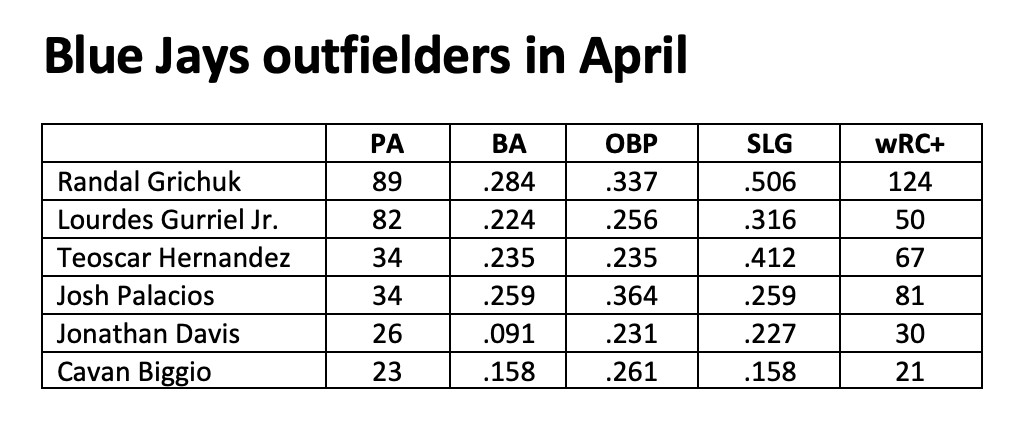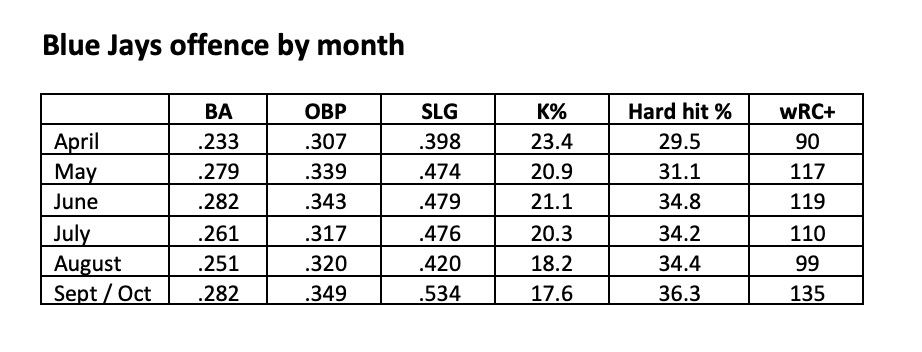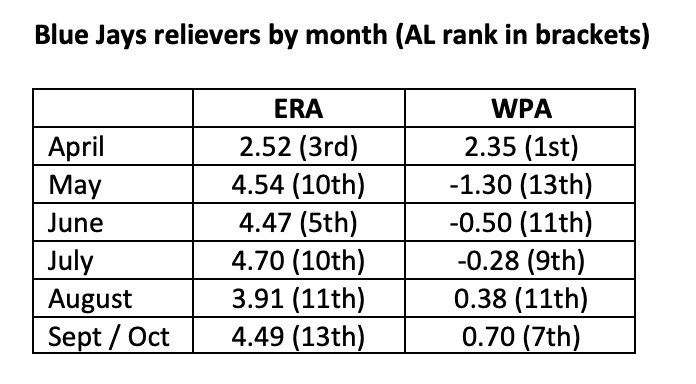TORONTO — About an hour after his team’s season ended in bitter disappointment, Marcus Semien did what he does and perfectly summarized what happened to the 2021 Toronto Blue Jays.
"We definitely didn't start off the way we wanted to this year. We were a young ball club; couple injuries. We just weathered the storm in the first half while playing in Dunedin and Buffalo," the veteran middle infielder said. "And then we got [to Toronto] and started to play good baseball. We traded for [Jose] Berrios. Our team really came together. We started to build a culture here. We had some fans to play in front of. And we became, in my opinion, the best team in baseball. But it was just a tick too late."
A tick late, a win short. They needed that big swing here, that play made there. Needed a winnable game they dropped to go the other way. Everyone has a different moment that sticks out in their memory when the Blue Jays stumbled, erred, or just plain didn’t capitalize and lost a heartbreaker. That was the one that cost them. That’s where it got away.
It almost makes you forget all the things that went right. Vladimir Guerrero Jr. and Semien, the 1-2 finishers in American League fWAR, are MVP candidates. Robbie Ray led the AL in both innings and ERA, and should soon have a Cy Young award to commemorate it. Four players drove in over 100 runs. The team led MLB in home runs with a franchise-record 262. Its starters finished third in AL rotation ERA. Toronto’s run differential was one-and-a-half that of the Red Sox and Yankees combined.
Bo Bichette led the AL in hits; Jordan Romano led it in WPA. Alek Manoah had the 10th-best ERA among AL pitchers to throw at least 100 innings. Teoscar Hernandez finished as a top-five AL outfielder offensively despite playing only five months. A compromised George Springer put up more homers and bWAR in half a season than fellow Blue Jays off-season targets DJ LeMahieu and Michael Brantley did in nearly full ones.
How does a team like that finish fourth in its division and miss the post-season? Disadvantageous league structure, for starters. The Blue Jays would have finished first in the NL East and second in three other divisions. But while they can’t do anything about that, there are factors under the club’s control that went awry this season, leading to the dispiriting result that will sting fans, players, and management alike for weeks to come.
Here’s where it went wrong for the Blue Jays. And what can be learned.
It wasn’t the top of the roster — it was the bottom
It goes without saying that the Blue Jays would be post-season bound if they’d gotten a fuller, heathier season from Springer. Extrapolate his stats to even just 140 games and you’re looking at a guy sitting on four fWAR as opposed to the 2.3 he provided in 78. There’s the extra win the Blue Jays needed right there.
But it wasn’t so much Springer’s early-season absence that hurt the Blue Jays — it was the inadequacy of those that played in his place. Here’s what Toronto ending up getting from its outfielders with Springer sidelined in April:

Somewhat ironically considering he was Toronto’s least productive regular over the course of the season, Randal Grichuk was the only thing saving the Blue Jays outfield from being an utter disaster that month. He handled the majority of Toronto’s centre field workload with Springer out and gave the club his hottest stretch of the year.
But a significant early-season slump from Lourdes Gurriel Jr. didn’t help. Nor did Hernandez contracting COVID-19 seven games into the year. That, coupled with Springer’s absence, created substantial playing time for down-roster outfielders Jonathan Davis and Josh Palacios, who weren’t able to backfill with even league-average production. Nor was Cavan Biggio, who played a handful of games in right.
Add that to the fact the Blue Jays were also regularly playing Rowdy Tellez (29 wRC+ over 63 April plate appearances) and Joe Panik (67 wRC+ over 67), and it’s easy to see why April ended up being Toronto’s least productive month by a mile. Blue Jays hitters posted a 90 wRC+ collectively as the team suffered nine losses by two runs or less.

April would’ve been a great time for Davis or Palacios to contribute even replacement level numbers; for Biggio to provide more than the .641 OPS he posted in a month when he led off on six occasions and hit second on seven others; for Tellez to have produced above the .489 OPS he mustered while playing every day for the first four weeks. Any one of those players stepping up with a big hit at the right time could have turned any of those two-run losses into the win Toronto needed to extend its season.
But the Blue Jays didn’t have enough quality depth behind their stars, an issue the club will need to address ahead of its next campaign. And not only on the position player side. When Kirby Yates, Julian Merryweather, and David Phelps were all lost to early-season injuries, Toronto didn’t have the relief depth to adequately cover their absences, either. Which leads nicely into this team’s next shortcoming…
Urgent times call for urgent measures
Considering how many holes were in the lineup — not to mention the fact that T.J. Zeuch and Tanner Roark were making starts — it was a minor feat for the Blue Jays to escape April with a 12-12 record. But for all those narrow losses, there was also an abundance of tight wins — five of them by two runs or fewer. And that was largely thanks to a bullpen that covered 100 April innings with a 2.52 ERA.
Oh, how things changed. By May, Toronto’s offence had awoken from its early-season slumber. Semien and Guerrero were on fire; a healthy Hernandez was making up for lost time; Grichuk was still hot; Gurriel was showing signs of life. But like Semien said — a tick too late. By then, a once-reliable bullpen was imploding on a regular basis, squandering the leads an improved offence was providing.
There was Joel Payamps coughing up a game-winning homer at the end of a late-April bullpen day in Kansas City. The four-game sweep in May when the Rays came to TD Ballpark and scored the winning run in the eighth inning or later each day. An array of Tyler Chatwood meltdowns, the worst coming in Cleveland in late May when he walked four straight in the final inning before allowing a game-ending sacrifice fly.
You had Trent Thornton turning a tie game into a blowout against the White Sox in early June. Rafael Dolis getting walked off twice in four nights at Fenway Park a week later. Anthony Castro allowing nine hits and two walks in 27 high leverage plate appearances. Hopes and prayers thrown behind waiver-wire sea-drift like Jacob Barnes, Jeremy Beasley, and Carl Edwards Jr. One of the AL’s best early-season bullpens was suddenly one of its worst.

Gradual improvements in Toronto’s offence and starting pitching helped mitigate what was a year-long relief issue. The Blue Jays bullpen faced 45.2 high leverage innings over the season’s first three months, but only 26.2 over the next three as it was handed more substantial leads to protect. And the eventual additions of Adam Cimber and Trevor Richards via trade were massive stabilizers over the back-half of the season.
But those reinforcements didn’t arrive soon enough. Even though the Blue Jays jumped the trade market by acquiring both weeks prior to the deadline, too much damage had been done. Of the dozen games the Blue Jays lost this season when leading in the seventh inning or later, nine came in May and June. Protect just a couple of those leads with more effective arms and the Blue Jays are still playing today.
If there’s a lesson here it’s that clubs with intentions of contending ought to operate with urgency no matter what the calendar says. Could Toronto have paid a steeper cost to execute the Cimber trade weeks earlier, perhaps by including a higher-upside prospect in the deal? Could they have paid a premium to acquire a different capable reliever from a non-contender even earlier?
It’s impossible to say. Other teams may not have been willing to budge. Trades are harder to make than you might think — particularly in May and June. But if there was a way to get it done, even at a high price, the Blue Jays needed to find it. You might not win the trade. But you might not lose the season.
The longest road trip they’ll ever take
So many incidentally helpful things happened over the final two months of the Blue Jays season — Springer getting healthy, Berrios being acquired, Gurriel going on a tear, someone in catcher’s gear finally producing offensively — that it’s tough to discern just how much of an impact the club’s arrival at Rogers Centre in late July had on the field. But to deny that the impact was positive is to deny common sense. And the Blue Jays record by location this season is telling:

But don’t even worry about the results. Just listen to the players. They’ll tell you exactly how much of a difference it made.
"There were a lot of losses early on that were tough to take. Losing with fans cheering against you at home, stuff like that. After the game, you'd come in and it sucked more than a normal May loss, you know?" Bichette said. “It has a lot of impact on a lot of different areas. It's definitely not an excuse. We had plenty of games that we could have won. And all of those games are on us. Really, it just put a little bit more on our mind than we needed. This game's really hard. Beating big-league teams is really hard. And I think that sometimes we just had more on our minds than we should have.”
He’s not just talking about the job on the field. Every player — coaches, management and staff members, too — had their own set of challenges coordinating housing in multiple locations, accommodating family members, living out of a suitcase for six months straight. It takes a toll.
"The big thing is just not having a flow. Not being where you're supposed to be. Not being home,” Springer said. “Once we understood that when we got [to Toronto] we weren't going anywhere, I think you saw a lot of guys just breathe and relax. Not have to be concerned about how to get their families from A to B and their stuff from A to B. We were able to just get here and play. Get to the park and enjoy it.”
Take Semien, who entered the season with three sons below the age of five, one of whom was born weeks before he signed with the Blue Jays in January. His wife, Tarah, and the three boys uprooted their lives in California to follow dad around throughout the season. At ballparks and hotels and restaurants. With diapers and paperwork and half-packed luggage. Through airports and uncertainty and strange places. While Semien played all 162.
“My wife, she held it down. All the travelling and taking care of the kids — taking care of a newborn this entire year,” Semien said. “I think that we were a little shellshocked early on. Just being from Oakland, living in our home, playing in Oakland — it was a lot easier. But we knew what we were getting into. I think that Toronto is a place that, for the guys with families, you know what it's going to be. You may be apart from your family a little bit more than other places. But in terms of the baseball, it's top notch.”
Would the Blue Jays have won more games if they’d arrived at Rogers Centre earlier? Would things have gone differently if they’d moved home, say, in mid-June when New York visited Buffalo and, before a vociferously pro-Yankees crowd, swept a three-game series in which the Blue Jays held a seventh-inning lead each night? It’s the biggest unknown of the season but also likely the biggest reason it ended when it did. A four-month road trip was just too much to overcome.
Logically, you’d expect professional athletes — generally highly motivated, extraordinarily incentivized, type-A individuals — to perform their best regardless of a game’s location. This is their livelihood; their paycheque. But who could deny the power of playing before true home fans at Rogers Centre after all we’ve seen? After a 9-2 run over the first homestand in 22 months. After the insane comeback against Oakland. After the week we all just watched.
"Every game for this last week felt like a playoff game. And you saw the results from us as an offence when you have that energy,” Semien said. “I can remember back in Oakland where we're in the race and the energy wasn't what we had here, to put it lightly. As a player, you feed off that energy. It's the most fun you can ever have at this level.”
So, yes, the Blue Jays were just a tick late, a win short. One big swing, one big strikeout, one defensive play made from continuing their season. It stings and this outcome could’ve been avoided. But you can’t restructure the divisions. You can’t reverse a pandemic or dictate governmental policy. You can learn from the experience. You can find the teachables. And you can come back better next year.
